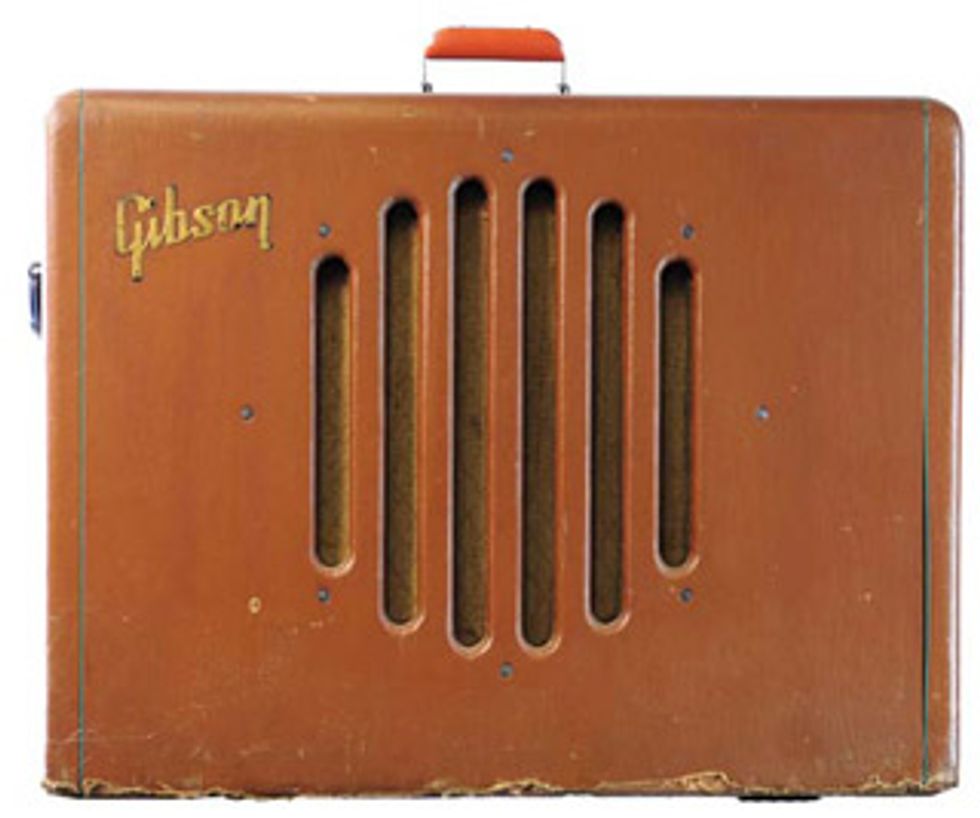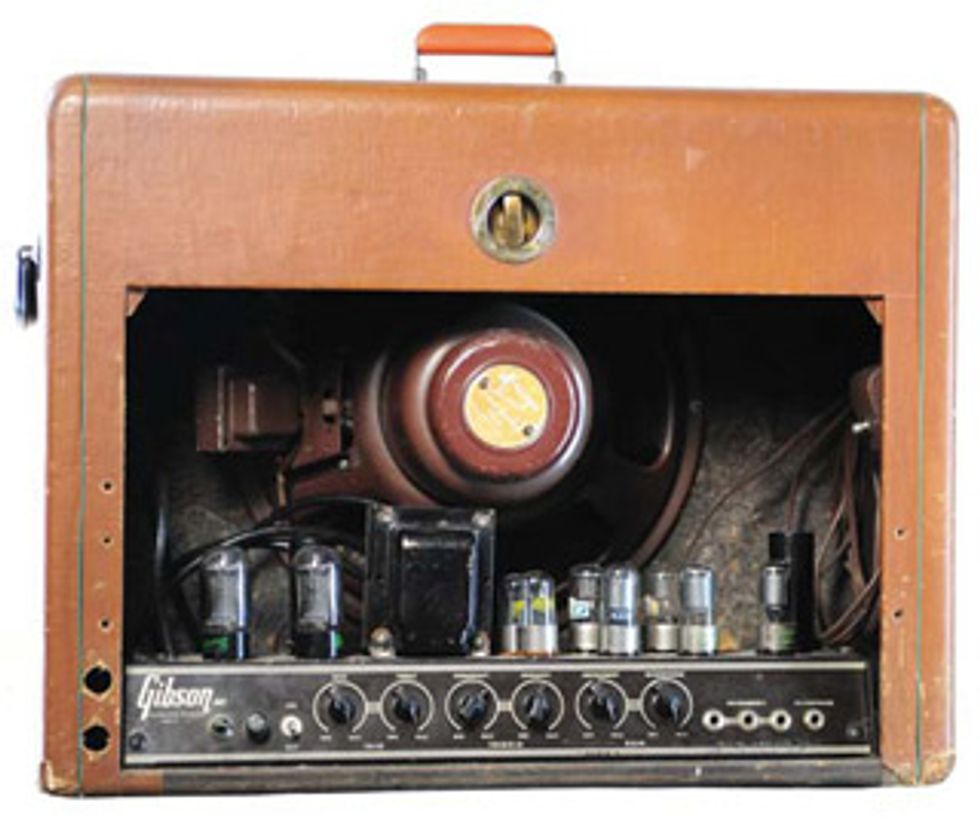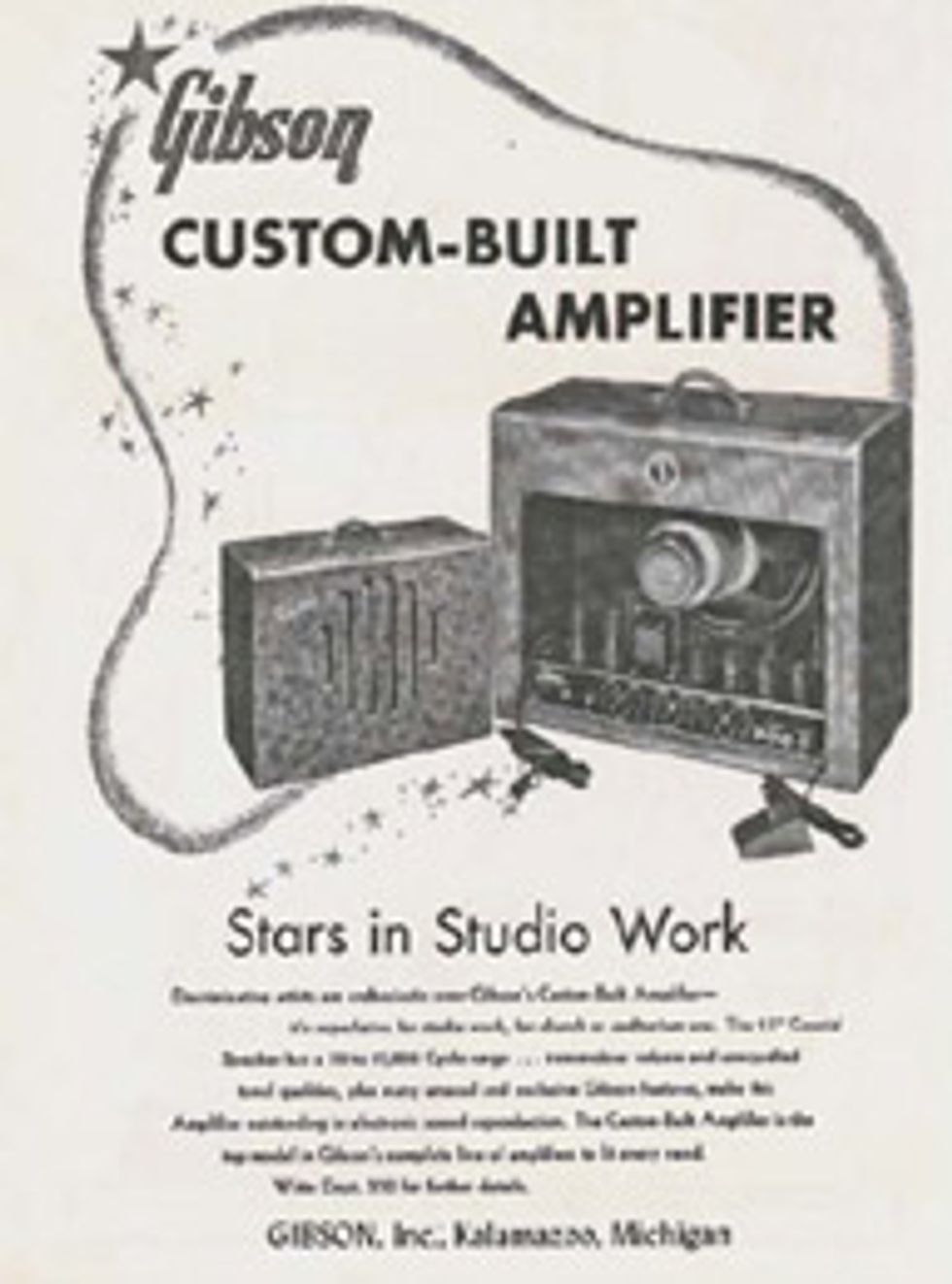Some amps are rare. Some amps are crazy-rare. Gibson’s Custom-Built amplifier, known as the GA-CB, is a couple of steps beyond any of that. An epic sound machine and the flagship of early postwar Gibson amplifiers, the GA-CB was a classic “halo” product: an exotic, feature-laden, high-priced offering standing head-and-shoulders above other models, produced in part to draw potential buyers to the other amps offered by Gibson.
Introduced in 1948, the Custom-Built led the new Gibson postwar amplifier line that included the GA-20, GA-25, GA-50, and GA-75. At this time, Gibson was undergoing a complete overhaul under the guidance of new president Ted McCarty. The BR line, a rush introduction intended to get Gibson back on the amp market in the first days after WWII, was on its way to oblivion, save for the diminutive, yet popular, BR-9. The new Gibson GA-series amps were designed by Seth Lover and Walter Fuller and, in a first for Gibson, built entirely at the Kalamazoo plant (with the exception of some cabinets built by an outside vendor). Offering amps was more than perfunctory for Gibson. The company had been in the amp business longer than almost anyone else, since 1933, and considered it a necessary part of the business of selling electric guitars. So although amp production was, in comparison to guitar, a secondary task at Gibson, it was nevertheless treated it as serious business.
The GA-CB was by far the most powerful, sophisticated, and expensive amplifier Gibson had ever built. It did, however, have a number of features one might expect on a pre-war amp. Most noticeable is the bottom-mounted chassis with rear-facing controls. This configuration was fine in the days when players mostly sat down, placing their amps in front of themselves. But in the late ‘40s, players were beginning to stand up more during performances, creating demand for easier access to control panels. In 1948, the GA-20 and GA-75 were Gibson’s only amps to offer top-mounted chassis with top-mounted controls. The GA-CB’s heavy-duty chassis held dual-6L6 power tubes that produced a little over 40 watts of power. The rest of the tube complement consisted of two 6J5, two 6S87, three 6SJ7 and a 5T4 rectifier. Controls were bass and treble, frequency and intensity for the Lover-designed tremolo circuit, and individual gain knobs for both the instrument and microphone channels.
The Custom-Built was covered in brown leatherette with green fabric pinstriping and a gold Gibson logo. The speaker opening consists of six vertical slats cut into the solid front of the cabinet with diamond- patterned grille cloth covering theopenings. Gibson would later realize that this type of speaker opening restricted speaker output and change to an opengrille format. The cabinet itself was large, a full four inches deeper than the next largest Gibson, the GA-75. While many of the Class of ’48 Gibsons were shallow rectangles resembling suitcases, the GA-CB seems almost a cube. The extradeep cabinet somewhat resembles a late- ‘40s Jensen Imperial Hi-Fi speaker, and it provides ample room for the brown-frame 15” Jensen Concert Type H Coaxial driver, of which Gibson claimed a “50 to 15,000 cycle range.” Incorporating a tweeter unit mounted inside the woofer, the Type H speaker was designed for use in Hi-Fi stereo systems. McCarty and Lover were wellknown Hi-Fi buffs and considered what was good for Hi-Fi to be good for guitar as well. This attitude is further in evidence by the presence of a Jensen four-position High Frequency Control unit located at the upper back of the GA-CB. The rotary control has four positions, at 10, 11, 1 and 2 o’clock (although it will hold at the 12 o’clock position as well).
Also offered on the higher-end models of Jensen home speakers, the High Frequency Control served to either impede or free the flow of upper-frequency signals to the driver. Coming in at 60 pounds, the GA-CB is fully double the weight of the GA-75. The added weight is a product of the heavy-duty driver, the larger chassis, the sturdy transformers, and the obvious heft of the cabinet wood.
In design, construction, price and tone, the GA-CB was beyond almost any other amplifier of the time. In fact, the GA-CB may have been the most advanced guitar amplifier of the early 1950s. In comparison to the Fender Pro, an amp that also featured dual 6L6 power tubes and a 15” speaker, the GA-CB has more power, more features and a higher-quality driver. Where the Fender beat the Gibson hands-down is in its guitar-specific voicing. Fender had learned that players were looking for a new, unique tone, something different from the sounds of the ‘30s. Gibson hadn’t gotten this message yet. While they may have been building higher-end amplifiers, they still had not moved significantly away from using lightly-modded PA circuits for their guitar amplifiers. Additionally, the entire Gibson team ascribed to a sound ideal that was smooth, mellow, and, above all, 100 percent distortion-free.
With the combination of higher power, a tremolo circuit, and the Jensen-designed High Frequency Control, Gibson offered with the GA-CB a package aimed squarely at the professional player. In advertisements of the time, Gibson touted the GA-CB as being “superlative for studio work, for church or auditorium use.” Cleary not an amp for greasy kids, twanging cowboys, or hard blues. By the end of its production run in 1953, only 108 GA-CB amps had been built. At $425 the GA-CB was a very expensive piece of equipment. Using the Consumer Price Index calculator, the GA-CB would cost today roughly $3835, a price similar to some of the currently available boutique, custom and high-power amplifiers. As for finding an actual GA-CB, few are known to exist. Even major collectors just shake their heads “no” when asked if they have a Custom- Built. Some recall an opportunity to buy long past, but most have never even seen one. The amplifier shown in these photos belongs to the collector and historian Lynn Wheelwright. Lynn found this amp online about ten years ago. A clean example such as this is almost unheard of, so it is an added bonus for gear fans that this particular amplifier will be on display at the Museum of Making Music in Carlsbad, CA, through March, 2010, as part of the exhibit: ON! The Beginnings of the Electric Sound Generation.
Wallace Marx Jr. is the author of Gibson Amplifiers, 1933-2008: 75 Years of the Gold Tone.
Introduced in 1948, the Custom-Built led the new Gibson postwar amplifier line that included the GA-20, GA-25, GA-50, and GA-75. At this time, Gibson was undergoing a complete overhaul under the guidance of new president Ted McCarty. The BR line, a rush introduction intended to get Gibson back on the amp market in the first days after WWII, was on its way to oblivion, save for the diminutive, yet popular, BR-9. The new Gibson GA-series amps were designed by Seth Lover and Walter Fuller and, in a first for Gibson, built entirely at the Kalamazoo plant (with the exception of some cabinets built by an outside vendor). Offering amps was more than perfunctory for Gibson. The company had been in the amp business longer than almost anyone else, since 1933, and considered it a necessary part of the business of selling electric guitars. So although amp production was, in comparison to guitar, a secondary task at Gibson, it was nevertheless treated it as serious business.
 |  |
| Photos: Lynn Wheelwright | |
The GA-CB was by far the most powerful, sophisticated, and expensive amplifier Gibson had ever built. It did, however, have a number of features one might expect on a pre-war amp. Most noticeable is the bottom-mounted chassis with rear-facing controls. This configuration was fine in the days when players mostly sat down, placing their amps in front of themselves. But in the late ‘40s, players were beginning to stand up more during performances, creating demand for easier access to control panels. In 1948, the GA-20 and GA-75 were Gibson’s only amps to offer top-mounted chassis with top-mounted controls. The GA-CB’s heavy-duty chassis held dual-6L6 power tubes that produced a little over 40 watts of power. The rest of the tube complement consisted of two 6J5, two 6S87, three 6SJ7 and a 5T4 rectifier. Controls were bass and treble, frequency and intensity for the Lover-designed tremolo circuit, and individual gain knobs for both the instrument and microphone channels.
The Custom-Built was covered in brown leatherette with green fabric pinstriping and a gold Gibson logo. The speaker opening consists of six vertical slats cut into the solid front of the cabinet with diamond- patterned grille cloth covering theopenings. Gibson would later realize that this type of speaker opening restricted speaker output and change to an opengrille format. The cabinet itself was large, a full four inches deeper than the next largest Gibson, the GA-75. While many of the Class of ’48 Gibsons were shallow rectangles resembling suitcases, the GA-CB seems almost a cube. The extradeep cabinet somewhat resembles a late- ‘40s Jensen Imperial Hi-Fi speaker, and it provides ample room for the brown-frame 15” Jensen Concert Type H Coaxial driver, of which Gibson claimed a “50 to 15,000 cycle range.” Incorporating a tweeter unit mounted inside the woofer, the Type H speaker was designed for use in Hi-Fi stereo systems. McCarty and Lover were wellknown Hi-Fi buffs and considered what was good for Hi-Fi to be good for guitar as well. This attitude is further in evidence by the presence of a Jensen four-position High Frequency Control unit located at the upper back of the GA-CB. The rotary control has four positions, at 10, 11, 1 and 2 o’clock (although it will hold at the 12 o’clock position as well).
Also offered on the higher-end models of Jensen home speakers, the High Frequency Control served to either impede or free the flow of upper-frequency signals to the driver. Coming in at 60 pounds, the GA-CB is fully double the weight of the GA-75. The added weight is a product of the heavy-duty driver, the larger chassis, the sturdy transformers, and the obvious heft of the cabinet wood.
In design, construction, price and tone, the GA-CB was beyond almost any other amplifier of the time. In fact, the GA-CB may have been the most advanced guitar amplifier of the early 1950s. In comparison to the Fender Pro, an amp that also featured dual 6L6 power tubes and a 15” speaker, the GA-CB has more power, more features and a higher-quality driver. Where the Fender beat the Gibson hands-down is in its guitar-specific voicing. Fender had learned that players were looking for a new, unique tone, something different from the sounds of the ‘30s. Gibson hadn’t gotten this message yet. While they may have been building higher-end amplifiers, they still had not moved significantly away from using lightly-modded PA circuits for their guitar amplifiers. Additionally, the entire Gibson team ascribed to a sound ideal that was smooth, mellow, and, above all, 100 percent distortion-free.
With the combination of higher power, a tremolo circuit, and the Jensen-designed High Frequency Control, Gibson offered with the GA-CB a package aimed squarely at the professional player. In advertisements of the time, Gibson touted the GA-CB as being “superlative for studio work, for church or auditorium use.” Cleary not an amp for greasy kids, twanging cowboys, or hard blues. By the end of its production run in 1953, only 108 GA-CB amps had been built. At $425 the GA-CB was a very expensive piece of equipment. Using the Consumer Price Index calculator, the GA-CB would cost today roughly $3835, a price similar to some of the currently available boutique, custom and high-power amplifiers. As for finding an actual GA-CB, few are known to exist. Even major collectors just shake their heads “no” when asked if they have a Custom- Built. Some recall an opportunity to buy long past, but most have never even seen one. The amplifier shown in these photos belongs to the collector and historian Lynn Wheelwright. Lynn found this amp online about ten years ago. A clean example such as this is almost unheard of, so it is an added bonus for gear fans that this particular amplifier will be on display at the Museum of Making Music in Carlsbad, CA, through March, 2010, as part of the exhibit: ON! The Beginnings of the Electric Sound Generation.
Wallace Marx Jr. is the author of Gibson Amplifiers, 1933-2008: 75 Years of the Gold Tone.




























































